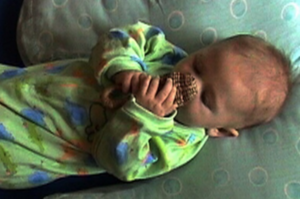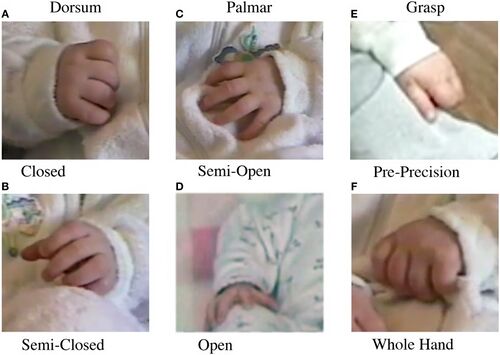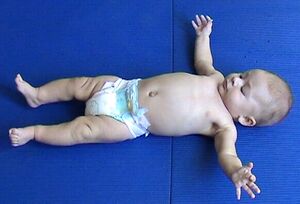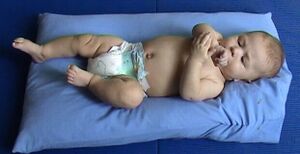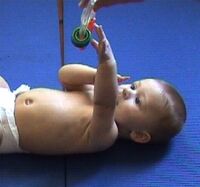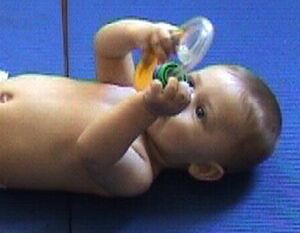Hand Function 0-7 months: Difference between revisions
No edit summary |
No edit summary |
||
| (16 intermediate revisions by 3 users not shown) | |||
| Line 2: | Line 2: | ||
'''Top Contributors''' - {{Special:Contributors/{{FULLPAGENAME}}}}</div> | '''Top Contributors''' - {{Special:Contributors/{{FULLPAGENAME}}}}</div> | ||
== Introduction == | == Introduction == | ||
From birth, infants use their hands to gather information about their bodies and surrounding surfaces. Spontaneous self-generated movements of their arms and legs provide contact with their environment. These spontaneous movements "provide a foundation for exploratory behavior from which body representation and a basic, implicit form of self-knowledge build".<ref name=":1">DiMercurio A, Connell JP, Clark M, Corbetta D. [https://www.frontiersin.org/articles/10.3389/fpsyg.2018.02613/full#:~:text=10.3389%2Ffpsyg.2018.02613-,A%20Naturalistic%20Observation%20of%20Spontaneous%20Touches%20to%20the%20Body%20and,First%202%20Months%20of%20Life&text=Self%2Dgenerated%20touches%20to%20the,body%20and%20self%20in%20infancy. A naturalistic observation of spontaneous touches to the body and environment in the first 2 months of life.] Frontiers in psychology. 2018:2613</ref> As their motor skills increase, infants can begin to reach and grasp objects in a variety of ways.<ref>LeBarton ES, Landa RJ. [https://www.sciencedirect.com/science/article/abs/pii/S0163638318300626 Infant motor skill predicts later expressive language and autism spectrum disorder diagnosis]. Infant Behavior and Development. 2019 Feb 1;54:37-47.</ref> This reaching motion enables an infant to bring their hands to a target while the grasping movement provides their hands with the opportunity to manipulate a toy or object.<ref>Thomas BL, Karl JM, Whishaw IQ. [https://www.researchgate.net/publication/271535351_Independent_development_of_the_Reach_and_the_Grasp_in_spontaneous_self-touching_by_human_infants_in_the_first_6_months Independent development of the Reach and the Grasp in spontaneous self-touching by human infants in the first 6 months]. Frontiers in psychology. 2015 Jan 8;5:1526.</ref> | |||
== Hands == | |||
Newborns | Newborns intuitively grasp objects that are placed in their hands, but not distant objects. At around 4 months old, infants can begin to reach for distant targets.<ref>Ek L, Eliasson AC, Sicola E, Sjöstrand L, Guzzetta A, Sgandurra G, Cioni G, Krumlinde-Sundholm L. [https://onlinelibrary.wiley.com/doi/epdf/10.1111/dmcn.14163 Hand Assessment for Infants: normative reference values.] Dev Med Child Neurol. 2019 Sep;61(9):1087-1092. </ref> At 12 months, an infant can use their arms to facilitate a "reach-to-grasp" that closely resembles an adult.<ref>Sacrey LA, Zwaigenbaum L, Bryson S, Brian J, Smith IM. [https://link.springer.com/article/10.1186/s11689-018-9259-4 The reach-to-grasp movement in infants later diagnosed with autism spectrum disorder: a high-risk sibling cohort study.] Journal of neurodevelopmental disorders. 2018 Dec;10(1):1-1.</ref> [[File:Babyhands2.png|alt=|thumb|Infant hand use.]]In addition to manipulating toys, infants aged 0-7 months use their hands for other purposes as well. Hand use during this stage can have the following objectives:<ref name=":0">Versfeld, P. Hand Function 0-7 month old Course. Plus. 2022</ref> | ||
# Gathering information about their bodies and surrounding surfaces | |||
# Interacting with objects they encounter | |||
# Communication | |||
# Body support and postural control | |||
Between 0 and 7 months, each step of hand development augments the next stage. From birth to 6-8 weeks, most hand movements are spontaneous in nature (see below). At 2-6 months old, exploratory hand actions, driven by curiosity, are supported by visual attention. At 6-8 months, infants can manipulate and grasp objects to make things happen. This is the first stage of goal-directed hand actions.<ref name=":0" /> | |||
== Self-Touching == | |||
[[File:Grasps.jpg|thumb|500x500px|Types of hand positioning for self-touch.|alt=]] | |||
From 0-24 weeks, self-touching exploration teaches infants about their face, body and surrounding surfaces.<ref name=":0" /> Self-touching helps the infant gather information about the extremity that is making contact with the body and where that extremity is in space.<ref name=":1" /> In their earlier weeks (up to 8 weeks), infants initially touch with their fists on the dorsum of their hands. Eventually (8-12 weeks) the fist transitions into a semi-closed position with contact on the side of the hand and back of the fingers. Contact with the hands during this early period are brief. As infants move into the 8-12 week period, contact time and exploration are increased, and finger manipulation begins. From 12-24 weeks, touch is more complex and the contact point is the palmar aspect of the hand. During this stage, infants can rotate their hands to explore objects.<ref name=":0" /> | |||
== | == Spontaneous Movements == | ||
[[File: | [[File:Will16w supine hands 2.jpg|thumb|Infant on firm, hard surface with extension of the lower extremities and abduction of the upper extremities.|alt=]] | ||
Whole-body general movements that are often seen in infants are referred to as spontaneous movements. These manoeuvres can last from several seconds to several minutes.<ref>Tsuji T, Nakashima S, Hayashi H, Soh Z, Furui A, Shibanoki T, Shima K, Shimatani K. [https://www.nature.com/articles/s41598-020-57580-z Markerless measurement and evaluation of general movements in infants]. Scientific reports. 2020 Jan 29;10(1):1-3.</ref> From birth to about 6-8 weeks these types of movements predominate. Spontaneous movements help the infant bring their hands into contact with their body and the surfaces within their visual field. A decrease in spontaneous movement occurs once an infant focuses on their hands or caregivers.<ref name=":0" />[[File:Will 16w supine hands 5 (2).jpg|thumb|300x300px|Infant on soft surface with flexed positioning.|alt=]]Different support surfaces can affect spontaneous movements of the limbs. On hard, firm surfaces, an infant in supine tends to place their lower extremities in extension and their upper extremities in abduction with elbow extension. This position on a hard surface results in less kicking and spontaneous movement. In contrast, an infant in supine on a soft surface tends to adopt a more flexed position of the lower extremities and the upper extremities are brought to the midline near the mouth. In this flexed position, the hands are open and are freely able to move to touch each other and the body.<ref name=":0" /> | |||
=== Spontaneous Movements | === Purpose of Spontaneous Movements === | ||
* Increase muscle strength | |||
* Increase muscle endurance | |||
* Increase sensory input | |||
* Maintain steady head in response to upper extremity perturbations | |||
* Shaping of the corticospinal tract<ref name=":0" /> | |||
* | |||
* | |||
* | |||
* | |||
* | |||
<nowiki>**</nowiki> Preterm and infants with developmental delay have less spontaneous movements<ref>Lev‐Enacab O, Sher‐Censor E, Einspieler C, Daube‐Fishman G, Beni‐Shrem S. [https://www.researchgate.net/publication/280915050_The_Quality_of_Spontaneous_Movements_of_Preterm_Infants_Associations_with_the_Quality_of_Mother-Infant_Interaction The quality of spontaneous movements of preterm infants: associations with the quality of mother–infant interaction]. Infancy. 2015 Nov;20(6):634-60.</ref> | <nowiki>**</nowiki> Preterm and infants with developmental delay have less spontaneous movements<ref>Lev‐Enacab O, Sher‐Censor E, Einspieler C, Daube‐Fishman G, Beni‐Shrem S. [https://www.researchgate.net/publication/280915050_The_Quality_of_Spontaneous_Movements_of_Preterm_Infants_Associations_with_the_Quality_of_Mother-Infant_Interaction The quality of spontaneous movements of preterm infants: associations with the quality of mother–infant interaction]. Infancy. 2015 Nov;20(6):634-60.</ref> | ||
== Intentional Reaching and Grasping == | |||
=== 3-4 Months === | |||
[[File:Will 23w reach.jpg|200x200px|alt=|thumb|Intentional reaching.]] | |||
At 3-4 months, infants will intentionally reach for objects, especially when they are introduced at the midline. <ref>Chinn LK, Noonan CF, Hoffmann M, Lockman JJ. [https://www.ncbi.nlm.nih.gov/pmc/articles/PMC6348757/pdf/fpsyg-10-00009.pdf Development of Infant Reaching Strategies to Tactile Targets on the Face.] Front Psychol. 2019 Jan 21;10:9. </ref> At around 10 weeks old, infants can bring their hands to the midline. Some of the characteristics of intentional reaching during this stage are listed below: | |||
* | * Reaching is preceded by the infant's visual attention on a toy | ||
* hand is set in an open position when initiating reach until | * The hand is set in an open position when initiating reach until the object is grasped | ||
* | * Small, repetitive movements of the fingers provide exploration of the toy's shape and texture | ||
* | * The infant loses their grasp of the toy when it is no longer within their visual field | ||
=== 5-6 Months === | |||
Intentional reach and grasp during the 5-6 month stage is characterised by the following: | Intentional reach and grasp during the 5-6 month stage <ref>Ferronato PA, Resende B, de Jesus Manoel E. Interweaving social and manipulative development in early infancy: Some direction for infant caregiving. Infant Behavior and Development. 2021 May 1;63:101564.</ref> is characterised by the following: | ||
* able to maintain grasp of toy even when not within visual field | * Infant is able to maintain their grasp of a toy even when it is not within their visual field | ||
* | * Infant can hold a toy with one hand and use the other hand to explore with their fingers[[File:Will 23w rattle1.jpg|thumb|Palmar grip.]] | ||
* | * Actions are more goal directed | ||
* | * Infant grabs different parts of the toy by using: | ||
** | ** Palmar-grip OR | ||
** | ** Thumb-to-forefinger grip | ||
* pass toy from one hand to the other | * Infant can pass the toy from one hand to the other | ||
* shake and bang toys | * Infant can shake and bang toys | ||
* | * When a new toy is introduced, the infant will drop the old toy | ||
* mouthing of toys | * There is mouthing of toys | ||
| Line 75: | Line 59: | ||
== Resources == | == Resources == | ||
* http://tomt.skillsforaction.com/dev/hands/tutorials-dev-hand-function | * [http://tomt.skillsforaction.com/dev/hands/tutorials-dev-hand-function Task Oriented Movement Therapy] | ||
* [[Understanding Newborn Behaviour]] | |||
* [[Newborn Perceptual Motor Behaviour]] | |||
* [[Hand Function]] | |||
== References == | == References == | ||
[[Category:Rehabilitation]] | [[Category:Rehabilitation]] | ||
[[Category:ReLAB | [[Category:ReLAB-HS Course Page]] | ||
[[Category:Course Pages]] | [[Category:Course Pages]] | ||
[[Category:Paediatrics]] | [[Category:Paediatrics]] | ||
Latest revision as of 15:52, 22 January 2023
Top Contributors - Robin Tacchetti, Jess Bell, Kim Jackson, Tarina van der Stockt and Ewa Jaraczewska
Introduction[edit | edit source]
From birth, infants use their hands to gather information about their bodies and surrounding surfaces. Spontaneous self-generated movements of their arms and legs provide contact with their environment. These spontaneous movements "provide a foundation for exploratory behavior from which body representation and a basic, implicit form of self-knowledge build".[1] As their motor skills increase, infants can begin to reach and grasp objects in a variety of ways.[2] This reaching motion enables an infant to bring their hands to a target while the grasping movement provides their hands with the opportunity to manipulate a toy or object.[3]
Hands[edit | edit source]
Newborns intuitively grasp objects that are placed in their hands, but not distant objects. At around 4 months old, infants can begin to reach for distant targets.[4] At 12 months, an infant can use their arms to facilitate a "reach-to-grasp" that closely resembles an adult.[5]
In addition to manipulating toys, infants aged 0-7 months use their hands for other purposes as well. Hand use during this stage can have the following objectives:[6]
- Gathering information about their bodies and surrounding surfaces
- Interacting with objects they encounter
- Communication
- Body support and postural control
Between 0 and 7 months, each step of hand development augments the next stage. From birth to 6-8 weeks, most hand movements are spontaneous in nature (see below). At 2-6 months old, exploratory hand actions, driven by curiosity, are supported by visual attention. At 6-8 months, infants can manipulate and grasp objects to make things happen. This is the first stage of goal-directed hand actions.[6]
Self-Touching[edit | edit source]
From 0-24 weeks, self-touching exploration teaches infants about their face, body and surrounding surfaces.[6] Self-touching helps the infant gather information about the extremity that is making contact with the body and where that extremity is in space.[1] In their earlier weeks (up to 8 weeks), infants initially touch with their fists on the dorsum of their hands. Eventually (8-12 weeks) the fist transitions into a semi-closed position with contact on the side of the hand and back of the fingers. Contact with the hands during this early period are brief. As infants move into the 8-12 week period, contact time and exploration are increased, and finger manipulation begins. From 12-24 weeks, touch is more complex and the contact point is the palmar aspect of the hand. During this stage, infants can rotate their hands to explore objects.[6]
Spontaneous Movements[edit | edit source]
Whole-body general movements that are often seen in infants are referred to as spontaneous movements. These manoeuvres can last from several seconds to several minutes.[7] From birth to about 6-8 weeks these types of movements predominate. Spontaneous movements help the infant bring their hands into contact with their body and the surfaces within their visual field. A decrease in spontaneous movement occurs once an infant focuses on their hands or caregivers.[6]
Different support surfaces can affect spontaneous movements of the limbs. On hard, firm surfaces, an infant in supine tends to place their lower extremities in extension and their upper extremities in abduction with elbow extension. This position on a hard surface results in less kicking and spontaneous movement. In contrast, an infant in supine on a soft surface tends to adopt a more flexed position of the lower extremities and the upper extremities are brought to the midline near the mouth. In this flexed position, the hands are open and are freely able to move to touch each other and the body.[6]
Purpose of Spontaneous Movements[edit | edit source]
- Increase muscle strength
- Increase muscle endurance
- Increase sensory input
- Maintain steady head in response to upper extremity perturbations
- Shaping of the corticospinal tract[6]
** Preterm and infants with developmental delay have less spontaneous movements[8]
Intentional Reaching and Grasping[edit | edit source]
3-4 Months[edit | edit source]
At 3-4 months, infants will intentionally reach for objects, especially when they are introduced at the midline. [9] At around 10 weeks old, infants can bring their hands to the midline. Some of the characteristics of intentional reaching during this stage are listed below:
- Reaching is preceded by the infant's visual attention on a toy
- The hand is set in an open position when initiating reach until the object is grasped
- Small, repetitive movements of the fingers provide exploration of the toy's shape and texture
- The infant loses their grasp of the toy when it is no longer within their visual field
5-6 Months[edit | edit source]
Intentional reach and grasp during the 5-6 month stage [10] is characterised by the following:
- Infant is able to maintain their grasp of a toy even when it is not within their visual field
- Infant can hold a toy with one hand and use the other hand to explore with their fingers
- Actions are more goal directed
- Infant grabs different parts of the toy by using:
- Palmar-grip OR
- Thumb-to-forefinger grip
- Infant can pass the toy from one hand to the other
- Infant can shake and bang toys
- When a new toy is introduced, the infant will drop the old toy
- There is mouthing of toys
Resources[edit | edit source]
- Task Oriented Movement Therapy
- Understanding Newborn Behaviour
- Newborn Perceptual Motor Behaviour
- Hand Function
References[edit | edit source]
- ↑ 1.0 1.1 DiMercurio A, Connell JP, Clark M, Corbetta D. A naturalistic observation of spontaneous touches to the body and environment in the first 2 months of life. Frontiers in psychology. 2018:2613
- ↑ LeBarton ES, Landa RJ. Infant motor skill predicts later expressive language and autism spectrum disorder diagnosis. Infant Behavior and Development. 2019 Feb 1;54:37-47.
- ↑ Thomas BL, Karl JM, Whishaw IQ. Independent development of the Reach and the Grasp in spontaneous self-touching by human infants in the first 6 months. Frontiers in psychology. 2015 Jan 8;5:1526.
- ↑ Ek L, Eliasson AC, Sicola E, Sjöstrand L, Guzzetta A, Sgandurra G, Cioni G, Krumlinde-Sundholm L. Hand Assessment for Infants: normative reference values. Dev Med Child Neurol. 2019 Sep;61(9):1087-1092.
- ↑ Sacrey LA, Zwaigenbaum L, Bryson S, Brian J, Smith IM. The reach-to-grasp movement in infants later diagnosed with autism spectrum disorder: a high-risk sibling cohort study. Journal of neurodevelopmental disorders. 2018 Dec;10(1):1-1.
- ↑ 6.0 6.1 6.2 6.3 6.4 6.5 6.6 Versfeld, P. Hand Function 0-7 month old Course. Plus. 2022
- ↑ Tsuji T, Nakashima S, Hayashi H, Soh Z, Furui A, Shibanoki T, Shima K, Shimatani K. Markerless measurement and evaluation of general movements in infants. Scientific reports. 2020 Jan 29;10(1):1-3.
- ↑ Lev‐Enacab O, Sher‐Censor E, Einspieler C, Daube‐Fishman G, Beni‐Shrem S. The quality of spontaneous movements of preterm infants: associations with the quality of mother–infant interaction. Infancy. 2015 Nov;20(6):634-60.
- ↑ Chinn LK, Noonan CF, Hoffmann M, Lockman JJ. Development of Infant Reaching Strategies to Tactile Targets on the Face. Front Psychol. 2019 Jan 21;10:9.
- ↑ Ferronato PA, Resende B, de Jesus Manoel E. Interweaving social and manipulative development in early infancy: Some direction for infant caregiving. Infant Behavior and Development. 2021 May 1;63:101564.
